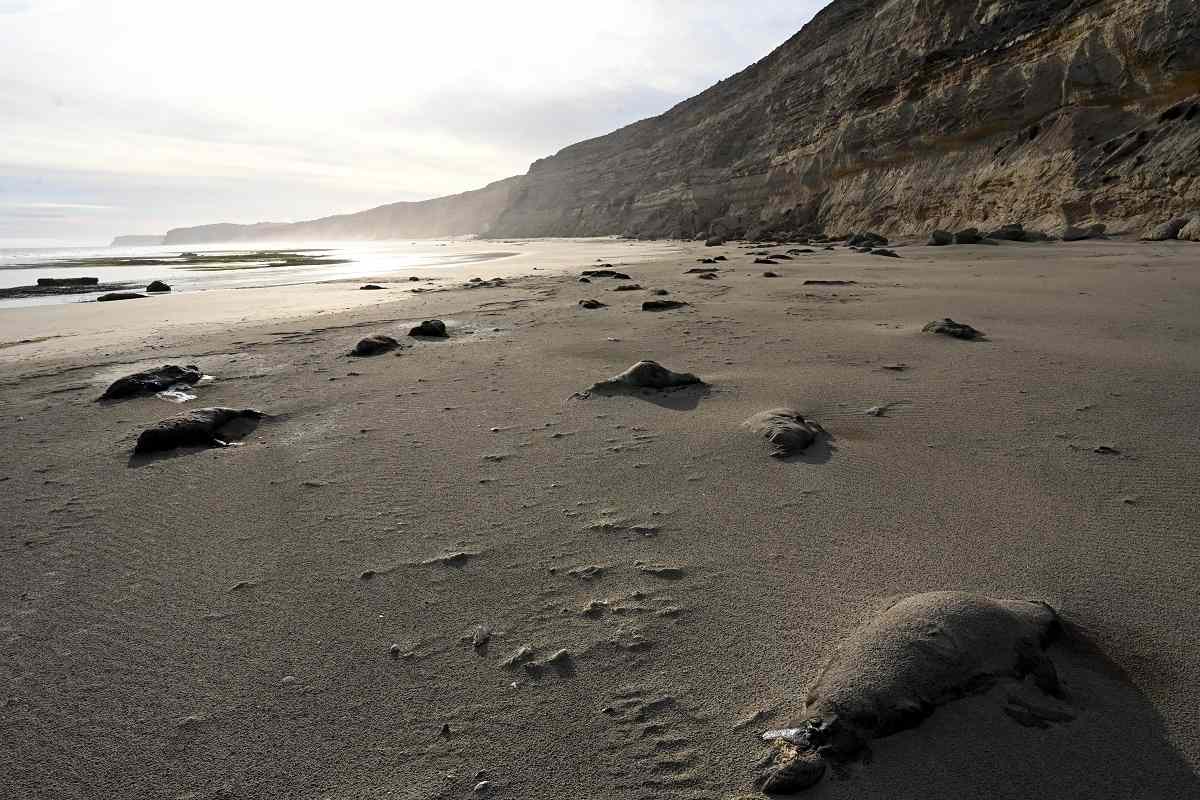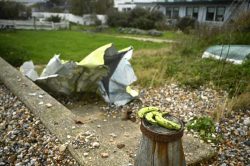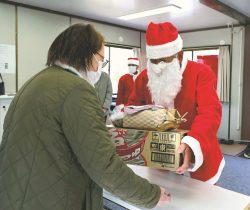An Unprecedented Flu Strain Is Attacking Hundreds of Animal Species. Humans Could Be Next.

Dead seal pups are spread out on a beach after adults abandoned the breeding area.
11:53 JST, January 16, 2024
It felt like watching one of those blockbusters about the end of the world. Like witnessing an apocalypse, but in real life. Which, in a way, it was.
The beaches of Valdes Peninsula in Argentina, normally so packed with elephant seals that time of year it is impossible to stroll along the shore, were desolate except for hundreds of dark, rotting carcasses – nearly a whole season of seal pups dead, with gulls pecking at the remains.
Instead of the usual cacophony of guttural honks that drowns out the waves during breeding season, the eerie silence was only broken by the sound of a few remaining elephant seals shaking their heads, snot running down their protruding, namesake noses.
“You felt like a bomb had exploded,” said Martín Méndez, recalling the scene he witnessed in October during an annual survey of southern elephant seals in that stretch of coastal Patagonia.
“It is catastrophic,” added the marine biologist at the Wildlife Conservation Society, a New York-based nonprofit group. “This is the largest die-off for the species, period.”
Altogether, an estimated 17,000 elephant seal pups seals died there last year from avian influenza, victims of an unprecedented panzootic – a pandemic among animals – that has struck around 320 types of birds and mammals.
Over the past few years, a potent strain of H5N1 avian influenza has jumped between species and raged through domestic and wild animal populations on every continent except Australia and Antarctica, crisscrossing the world along birds’ migratory routes.
So far, cases of humans getting seriously sick from this strain of flu are rare. But the possibility of the quickly evolving influenza virus gaining the ability to be transmitted between from one mammal to another – and eventually, to humans – has scientists concerned about the pathogen turning into another pandemic. “Every year that this doesn’t happen,” Méndez said, “we’re being lucky.”
For poultry farmers, the outbreak has already come at a significant economic cost, striking tens of millions of birds in the United States. For wildlife, it threatens to disrupt ecosystems and push endangered animals closer to the brink of extinction.
“We’ve never seen such a massive spread of virus in wild birds, and we’ve never seen such massive infections of wild mammals,” said Ron Fouchier, a virologist at the Erasmus University Medical Center in the Netherlands.
The trajectory of the virus, unprecedented both in its global spread and in the number of species infected, shows how dependent and connected humanity is to the natural world – and how farming practices that facilitate the flu can disrupt it.
‘I was not prepared’
Scientists first spotted the precursor to this flu strain in commercial geese in southern China in 1996. Over the next several years, it spread to poultry farms in the region, popping up occasionally in wild birds within flight range of infected farms.
Then, in 2005, some 1,500 wild geese and gulls dropped dead in a protected nature reserve in northwestern China, far from any poultry coops. The virus had found its way into the wild bird population.
From there, the virus rapidly spread across Asia, Africa and Europe, popping up in seasonal outbreaks. But it was only after a genetic change that allowed the pathogen to spread in migrating birds around 2021 that the numbers of outbreaks exploded and the virus went global, establishing itself in North America that year and in South America the following.
Since then, the death toll has been staggering.
About 5,200 common cranes in Israel. More than 2,200 Dalmatian pelicans in Greece, about 40 percent of the species in southeastern Europe, and roughly 20,000 Sandwich terns in Europe, 17 percent of the northwest European breeding population. More than 18,000 dead barnacle geese in Scotland. And tens of thousands of gannets in Canada.
Last year, ornithologists found about 12,000 dead black-legged kittiwakes in Norway. By July, more than 500,000 birds died in South America, including about 41 percent of all Peruvian pelicans.
Flu symptoms depend on the bird, according to Jonas Waldenström, a disease ecology professor at Linnaeus University in Sweden. Telltale signs include tilting heads, struggling to stand and tumbling when trying to take flight – all signs the virus has hit the nervous system.
“In some species, it’s pretty ugly,” he said.
The virus is literally reaching the ends of the Earth, killing brown skuas on islands near Antarctica and, for the first time just this winter, a polar bear in Alaska. Scientists worry it is only a matter of time before it reaches penguins and other vulnerable populations on Antarctica itself.
“The Antarctic situation is at a precipice,” said Michelle Wille, a virus ecologist at the University of Melbourne. “Many of the animal species that live there are found no where else in the world, and many are already facing substantial pressures due to things like fisheries and climate change.”
Scientists say the disease can jump between species when a wild animal eats a dead or dying bird, or when bird poop plops into a farm animal’s feed. So far, bird flu has infected coyotes, lions, tigers, grizzlies, raccoons, red foxes and other terrestrial mammals, but only sporadically. And it has also struck farms for mink and fox fur in Spain and Finland.
But a series of mass die-offs of marine mammals that congregate on beaches has biologists worried about the possibility of the virus evolving to spread directly from one mammal to another.
Last year, more than 5,000 sea lions were found dead in Peru. And more than 17,000 elephant seal pups succumbed to the virus in Argentina, representing at least 96 percent of the juvenile population. Nursing seal pups likely would not have caught the flu by eating birds. They instead may have gotten it from contaminated milk, water, aerosol or feces, Fouchier said.
Valeria Falabella, a Wildlife Conservation Society marine biologist who has studied Argentina’s elephant seals for decades, had only ever seen a dead adult once before this flu outbreak. Seeing beaches of dozens dead was “absolutely devastating.”
“I was not prepared to see that,” Falabella said.
The risk to people
If a bird flu virus evolves to spread between seals, it is more likely to spread within other mammal populations, such as humans. “It’s quite a distance from a gannet to human,” Waldenström said. “But from a seal to a human, we’re pretty much alike.”
Tracing how viruses hop between species is hard. In the past, humans have caught disease from animals after working on farms (the 1918 flu pandemic likely started in Kansas farm country) or after encroaching into wilderness (HIV likely jumped from chimpanzees when a hunter killed one for meat).
In the case of the latest flu strain, it is “very difficult to prove mammal-to-mammal transmission,” Fouchier said, adding that a genetic analysis of the virus found in the dead seals could provide clues about transmission.
So far, what we know about this strain of avian flu suggests an outbreak among humans is not imminent. The adaptation that the virus made to replicate in migratory birds – and thus spread across the globe – seems to have inhibited its ability to infect humans, Fouchier said.
“It is slightly less concerning to human health at present,” he said, compared to past flu viruses. But given the unprecedented nature of the ongoing outbreak it’s hard to predict how it will evolve. “A typical bird flu virus never makes it into mammals at this scale,” he added.
The longer the virus persists in the environment, the more opportunities it has to fuel a new pandemic. Influenza viruses evolve much faster than the coronavirus behind the covid pandemic and other pathogens.
Right now, there is little to do to stop the spread of this flu virus among wildlife. The U.S. Fish and Wildlife Service, for instance, is working with zoos to vaccinate critically endangered California condors.
“It’s hard to contain a virus that’s now on more or less all the continents,” Waldenström said. “There’s no putting the lid on that. It will run its course.”
But there are steps the poultry industry can take – monitoring for viruses at farms, disinfecting equipment, having workers wear protective gear – to reduce the risk of future outbreaks, according to Jonathan Sleeman, a science adviser for wildlife health at the U.S. Geological Survey. “One recognizes that this is a lot of effort,” he said.
For the surviving elephant seal population in Argentina, it may take years to come back. “They may never recover to the same level of population as they were before,” Sleeman said. Biologists are working to understand how many adult seals died.
Méndez, the biologist who likened the seal die-off to a disaster movie, worries how the recent outbreak may undo decades of conservation work.
Now, the virus has transformed their work. It’s about more than just aiding faraway animals – it’s about protecting people, too.
“We’re really trying to protect the very functioning of our planet,” Méndez said. “We’re looking at this disruption through the lens of wildlife, but this is obviously very serious for humans as well.
"News Services" POPULAR ARTICLE
-

American Playwright Jeremy O. Harris Arrested in Japan on Alleged Drug Smuggling
-

Japan’s Nikkei Stock Average as JGB Yields, Yen Rise on Rate-Hike Bets
-

Japan’s Nikkei Stock Average Licks Wounds after Selloff Sparked by BOJ Hike Bets (UPDATE 1)
-

Japanese Bond Yields Zoom, Stocks Slide as Rate Hike Looms
-

Japan’s Nikkei Stock Average Buoyed by Stable Yen; SoftBank’s Slide Caps Gains (UPDATE 1)
JN ACCESS RANKING
-

Keidanren Chairman Yoshinobu Tsutsui Visits Kashiwazaki-Kariwa Nuclear Power Plant; Inspects New Emergency Safety System
-

Imports of Rare Earths from China Facing Delays, May Be Caused by Deterioration of Japan-China Relations
-

University of Tokyo Professor Discusses Japanese Economic Security in Interview Ahead of Forum
-

Japan Pulls out of Vietnam Nuclear Project, Complicating Hanoi’s Power Plans
-

Govt Aims to Expand NISA Program Lineup, Abolish Age Restriction

























